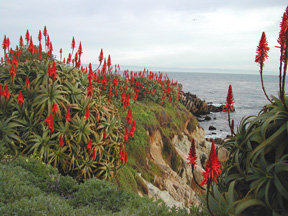Aloe -A Valentine Beauty

Published: February, 2005
Aloe plants are striking when the spring spires of red flowers reach to the sky. A large variety lines the shoreside pathways of the coastal town of Pacific Grove. The beneficial plant helps hold back erosion in a most attractive manner. Bay Area use of these valued plants just might be a beautiful addition to many landscapes.
Fascinating Growth
In countries where the rare Aloes are native, they have become almost extinct and are protected by their governments from poaching. Some aloes are only 1-inch long, yet others grow into 40-foot trees with bright shiny flowers. The pigmentation of the plants varies greatly, and most have rows of teeth or toothy spination.
The popular group of Aloe consists of about 300 varieties of succulent plants, which were originally found from Arabia to South Africa. They grow in the form of small, stemless rosettes of fleshy leaves to huge tree varieties. Smaller varieties and hybrids make great container plants, while most are excellent for use as landscape plants in warm regions. The leaves of these succulents grow from the center of the plant and can range in length from 10 inches to 2 feet. The thick, fleshy leaves are able to store great amounts of water during a rainy season and are therefore able to survive droughts.
Many kinds of Aloes bear pretty spikes of flowers. In winter and spring, flower stems bearing bunches of tubular-shaped flowers are produced. The long-lasting blossoms may be red, orange, green, or sometimes yellow. They are followed by small, green berries.
A. dichotoma (Tree Aloe) is one of the largest species in the group, reaching 40 feet in height. The individual rosettes, growing up to 12 inches wide, are made up of dull green leaves that are 2 inches wide and 8 inches long. In the winter, a few spikes of yellow flowers are produced. A. harlanii is a handsome variety that is suitable for growing as a houseplant. Pale green leaves, banded with dark green, grow in rosettes 7 inches in diameter. In the spring, spikes of pale pink flowers are produced.
The dried juice of the leaves of several Aloes, but mainly A. vera, is commonly used to relieve some skin irritations, such as burns, sunburns, and cuts. In recent years, Aloe has been considered one of the wonder plants used in a liquid claiming to contribute to longer life; in powdered form, there are claims that it can aid up 75 ailments, which is why it is becoming endangered in its native countries. The leaves are broken and the oozing juice is collected in containers. Artificial heat is used to evaporate the required amount of moisture. The residue from the leaves of A. vera is known as Barbados Aloes and Curacao Aloes.
For Valentine’s Day, if your love wants a change from roses or might prefer a long-lived plant as a sign of affection, Aloe does not ask a lot: it heals all kinds of hurts and is attractive year round. If you’re looking for a romantic getaway, a trip to Pacific Grove is another consideration to see the Aloe in full bloom along the shoreside trails leading west from Lover’s Point.

